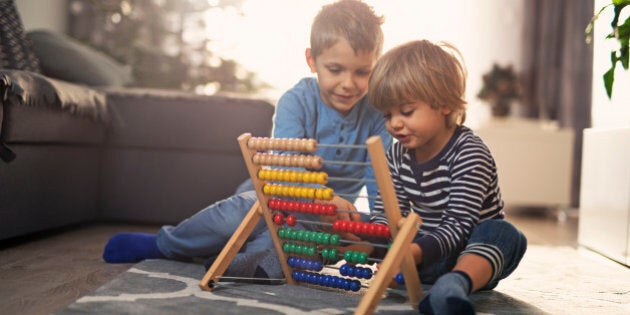
Both parents and teachers are confronted with students who have persistent difficulties with math concepts and operations. In my years as an active school psychologist, as well as in my current practice, I have received many referrals of students of all ages who make mistakes with--or who do not grasp--even the most basic arithmetic concepts. These students typically rely on something very concrete, such as their fingers, to achieve any sort of accuracy at all. They do not easily make the transition to "mental math," and therefore do not develop quick mental calculating speed.
Using fingers and counting dots to answer basic calculations is an acceptable strategy in the early stages of mastery, but this approach needs to be replaced with a more efficient strategy. "More practice" is a typical suggestion for overcoming math difficulties. However, the "skill and drill" exercises recommended often do not address students' underlying problems. Given the sequential nature of mathematics instruction and development, early difficulty in arithmetic has a cumulative effect, and students who have a weak foundation by the end of Grade 1 do not typically catch up by the end of Grade 2. In fact, by the time they graduate from high school, many of those same students do not attain arithmetic proficiency beyond Grade 6 level.
Is there anything that can be done? Of course, and the key is starting early.
Developing numerical ability depends on several foundational skills that are already inherent. It has been shown that animals from rats to chimpanzees can perform simple math approximations involving the numbers 1, 2 and 3. It also appears that young babies have a sense of numbers even before they can speak.
So, when children are young (say, ages 2 to 4), they need to be exposed to counting, memorizing numerals and recognizing numerical representations. Learning and memorizing the "1,2,3s" is as important as learning and memorizing the "A,B,Cs." There are many wonderful books that can introduce even the youngest children to numbers. A judicious use of Internet activities can also supplement one-to-one teaching time with your child.
Once children understand the "1,2,3s," we can start nurturing an understanding of numerical representation. Children must learn that a written numeral "stands for" something, (i.e., objects) in the same way they need to learn that a letter "stands for" something (i.e., sounds). However, sounds are abstract entities while numerals are concrete representations.
Numbers and what they represent can be introduced in a very concrete way to children between ages 4 and 6. That is relatively easy (compared to letters and sounds) because you can show how concrete objects can be represented by a numeral. The numeral "1" can represent one block, "2" matches two blocks, etc. Once this correspondence is introduced, children should be taught to count to 10 and place a block beside each numeral they say until they reach 10. Our system is largely based on 10, making it a very important number. Once "10" is established, the child can be taught to count by 10s up to 100.
Starting around age 6, children are ready to learn how sets of 10 can be grouped and re-grouped in several ways. For example, we can arrive at 10 by skip counting or adding by multiples of 2. That gives us 5 groups of 2. Or we can add 5 and 5, or 4 and 6, etc. to arrive at 10 each time. One excellent website guides children through fun exercises that help build stronger numerical understanding. The free website was developed by a European consortium of experts. Children advance through skill levels that provide practice with grouping, regrouping and other concepts necessary for mathematics in Grade 1 and beyond. Keep in mind that, while the website includes many excellent basic foundation-building activities, the "Expert Level" does not go nearly far enough for many students' needs. As well, the activities don't involve anything beyond the number 40 and are restricted to adding and subtracting at this point.
Young children can also be introduced to such numerical concepts as "fewer than," "larger than," "more than," "less than" and so on. Demonstrate these concepts with objects like toy cars or blocks. Arrange a row of 4 blocks with another row of 3 blocks below. Ask your child which row has "more." Then space the 3 objects on the bottom line to become much wider across than the top row and ask them which row has "more." This classic experiment was used by pioneering child psychologist Jean Piaget to demonstrate that children do not have the sense of number constancy. More recent and sophisticated experiments have, however, revealed flaws in Piaget's reasoning. Part of the difficulty for the child is the language of questioning itself. If you use edibles the child likes--instead of blocks or toy cars--and ask which row they would choose to eat, it is likely that your child will pick the row with 3 edibles, even if spatially it appears much "bigger" than the row of 4. Present your child with enticing edibles in varying row lengths and widths, and you will likely see them begin to gain a sense of number constancy.
Children in older grades who struggle with basic calculations likely need to complete some remedial work. "Skill and drill" activities can be partly helpful, but students who struggle typically need a re-teaching of the most fundamental steps. Current curriculum methods overemphasize discovery and underplay the importance of learning basic operations in a systematic way. Automaticity can be practiced with "skill and drill" activities, once the process of operation is understood. And understanding those processes needs to transition from a concrete representation to a mental one, using both language and visualization.
In the long run, children need to make the shift from concrete representation in mathematics to mental representations if they are to move beyond using their fingers to begin to utilize a more efficient and reliable approach.
Follow HuffPost Canada Blogs on Facebook